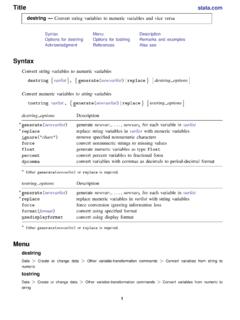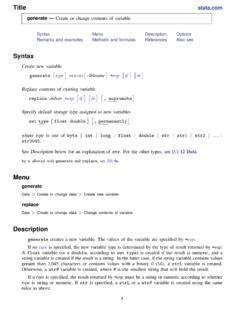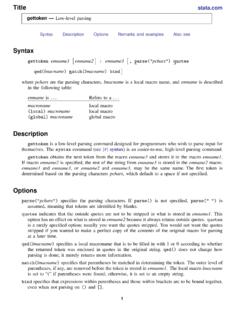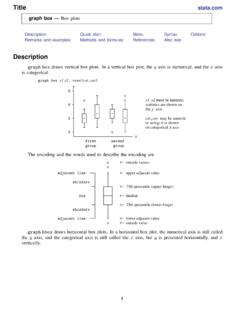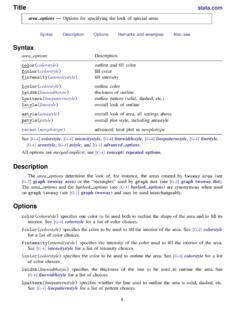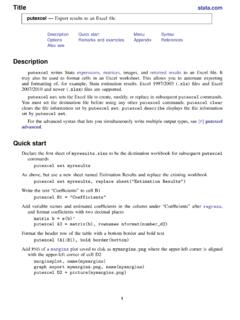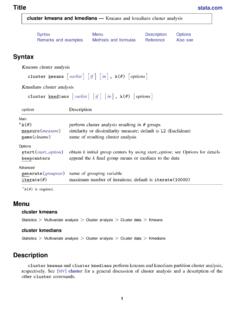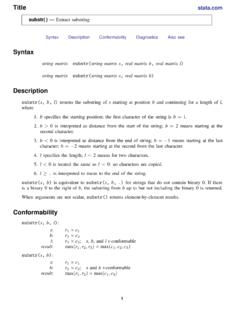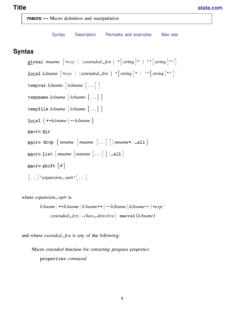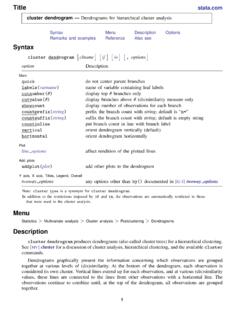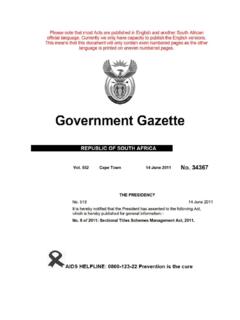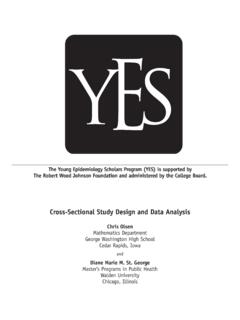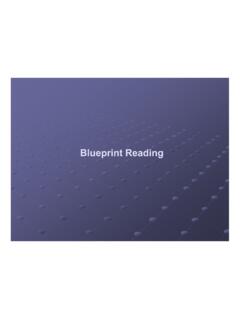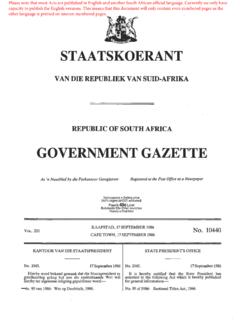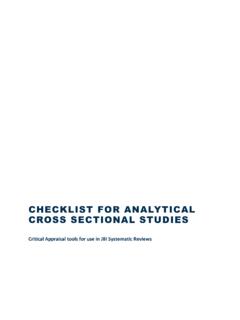Transcription of Stata: Software for Statistics and Data Science | Stata
1 Title xtgls Fit panel-data models by using GLS. Syntax Menu Description Options Remarks and examples Stored results Methods and formulas References Also see Syntax . xtgls depvar indepvars if in weight , options options Description Model noconstant suppress constant term panels(iid) use error structure panels(heteroskedastic) use heteroskedastic but uncorrelated error structure panels(correlated) use heteroskedastic and correlated error structure corr(independent) use independent autocorrelation structure corr(ar1) use AR1 autocorrelation structure corr(psar1) use panel-specific AR1 autocorrelation structure rhotype(calc) specify method to compute autocorrelation parameter;. see Options for details; seldom used igls use iterated GLS estimator instead of two-step GLS estimator force estimate even if observations unequally spaced in time SE.
2 Nmk normalize standard error by N k instead of N. Reporting level(#) set confidence level; default is level(95). display options control column formats, row spacing, line width, display of omitted variables and base and empty cells, and factor-variable labeling Optimization optimize options control the optimization process; seldom used coeflegend display legend instead of Statistics A panel variable must be specified. For correlation structures other than independent, a time variable must be specified. A time variable must also be specified if panels(correlated) is specified. Use xtset; see [XT] xtset. indepvars may contain factor variables; see [U] Factor variables. depvar and indepvars may contain time-series operators; see [U] Time-series varlists.
3 By and statsby are allowed; see [U] Prefix commands. aweights are allowed; see [U] weight. coeflegend does not appear in the dialog box. See [U] 20 Estimation and postestimation commands for more capabilities of estimation commands. 1. 2 xtgls Fit panel-data models by using GLS. Menu Statistics > Longitudinal/panel data > Contemporaneous correlation > GLS regression with correlated disturbances Description xtgls fits panel-data linear models by using feasible generalized least squares. This command allows estimation in the presence of AR(1) autocorrelation within panels and cross- sectional correlation and heteroskedasticity across panels. Options . Model noconstant; see [R] estimation options. panels(pdist) specifies the error structure across panels.
4 Panels(iid) specifies a homoskedastic error structure with no cross- sectional correlation. This is the default. panels(heteroskedastic) specifies a heteroskedastic error structure with no cross- sectional correlation. panels(correlated) specifies a heteroskedastic error structure with cross- sectional correlation. If p(c) is specified, you must also specify a time variable (use xtset). The results will be based on a generalized inverse of a singular matrix unless T m (the number of periods is greater than or equal to the number of panels). corr(corr) specifies the assumed autocorrelation within panels. corr(independent) specifies that there is no autocorrelation. This is the default. corr(ar1) specifies that, within panels, there is AR(1) autocorrelation and that the coefficient of the AR(1) process is common to all the panels.
5 If c(ar1) is specified, you must also specify a time variable (use xtset). corr(psar1) specifies that, within panels, there is AR(1) autocorrelation and that the coefficient of the AR(1) process is specific to each panel. psar1 stands for panel-specific AR(1). If c(psar1). is specified, a time variable must also be specified; use xtset. rhotype(calc) specifies the method to be used to calculate the autocorrelation parameter: regress regression using lags; the default dw Durbin Watson calculation freg regression using leads nagar Nagar calculation theil Theil calculation tscorr time-series autocorrelation calculation All the calculations are asymptotically equivalent and consistent; this is a rarely used option. igls requests an iterated GLS estimator instead of the two-step GLS estimator for a nonautocorrelated model or instead of the three-step GLS estimator for an autocorrelated model.
6 The iterated GLS. estimator converges to the MLE for the corr(independent) models but does not for the other corr() models. xtgls Fit panel-data models by using GLS 3. force specifies that estimation be forced even though the time variable is not equally spaced. This is relevant only for correlation structures that require knowledge of the time variable. These correlation structures require that observations be equally spaced so that calculations based on lags correspond to a constant time change. If you specify a time variable indicating that observations are not equally spaced, the (time dependent) model will not be fit. If you also specify force, the model will be fit, and it will be assumed that the lags based on the data ordered by the time variable are appropriate.
7 SE. nmk specifies that standard errors be normalized by N k , where k is the number of parameters estimated, rather than N , the number of observations. Different authors have used one or the other normalization. Greene (2012, 280) remarks that whether a degree-of-freedom correction improves the small-sample properties is an open question.. Reporting level(#); see [R] estimation options. display options: noomitted, vsquish, noemptycells, baselevels, allbaselevels, nofvla- bel, fvwrap(#), fvwrapon(style), cformat(% fmt), pformat(% fmt), sformat(% fmt), and nolstretch; see [R] estimation options.. Optimization optimize options control the iterative optimization process. These options are seldom used. iterate(#) specifies the maximum number of iterations.
8 When the number of iterations equals #, the optimization stops and presents the current results, even if convergence has not been reached. The default is iterate(100). tolerance(#) specifies the tolerance for the coefficient vector. When the relative change in the coefficient vector from one iteration to the next is less than or equal to #, the optimization process is stopped. tolerance(1e-7) is the default. nolog suppresses display of the iteration log. The following option is available with xtgls but is not shown in the dialog box: coeflegend; see [R] estimation options. Remarks and examples Remarks are presented under the following headings: Introduction Heteroskedasticity across panels Correlation across panels (cross- sectional correlation).
9 Autocorrelation within panels 4 xtgls Fit panel-data models by using GLS. Introduction Information on GLS can be found in Greene (2012), Maddala and Lahiri (2006), Davidson and MacKinnon (1993), and Judge et al. (1985). If you have many panels relative to periods, see [XT] xtreg and [XT] xtgee. xtgee, in particular, provides capabilities similar to those of xtgls but does not allow cross- sectional correlation. On the other hand, xtgee allows a richer description of the correlation within panels as long as the same correlations apply to all panels. xtgls provides two unique features: 1. Cross- sectional correlation may be modeled (panels(correlated)). 2. Within panels, the AR(1) correlation coefficient may be unique (corr(psar1)).
10 Xtgls allows models with heteroskedasticity and no cross- sectional correlation, but, strictly speaking, xtgee does not. xtgee with the vce(robust) option relaxes the assumption of equal variances, at least as far as the standard error calculation is concerned. Also, xtgls, panels(iid) corr(independent) nmk is equivalent to regress. The nmk option uses n k rather than n to normalize the variance calculation. To fit a model with autocorrelated errors (corr(ar1) or corr(psar1)), the data must be equally spaced in time. To fit a model with cross- sectional correlation (panels(correlated)), panels must have the same number of observations (be balanced). The equation from which the models are developed is given by yit = xit + it where i = 1.
